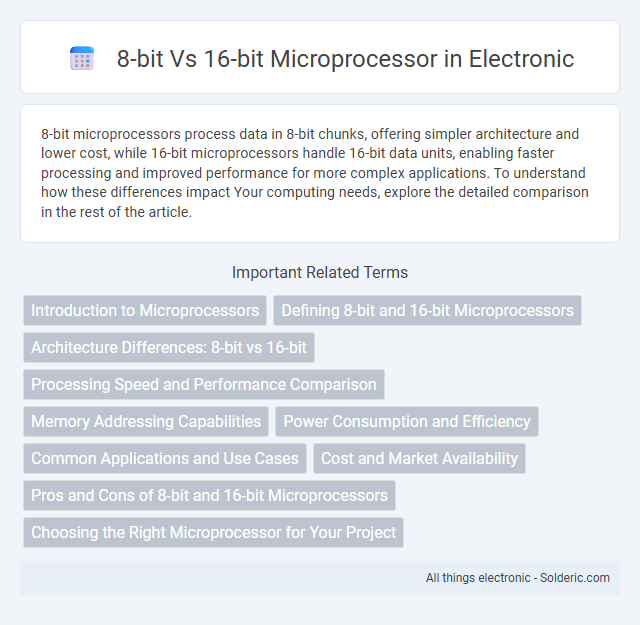8-bit microprocessors process data in 8-bit chunks, offering simpler architecture and lower cost, while 16-bit microprocessors handle 16-bit data units, enabling faster processing and improved performance for more complex applications. To understand how these differences impact Your computing needs, explore the detailed comparison in the rest of the article.
Comparison Table
| Feature | 8-bit Microprocessor | 16-bit Microprocessor |
|---|---|---|
| Data Bus Width | 8 bits | 16 bits |
| Address Bus Width | 16 bits (up to 64 KB memory) | 20-24 bits (up to 1 MB+ memory) |
| Processing Power | Lower, suitable for simple tasks | Higher, better for complex calculations |
| Instruction Set | Limited, simpler instructions | Expanded, more complex instructions |
| Performance | Slower execution speed | Faster execution speed |
| Memory Handling | Supports smaller memory | Supports larger memory |
| Typical Applications | Embedded systems, simple devices | Industrial controllers, advanced systems |
| Examples | Intel 8080, Zilog Z80 | Intel 8086, Motorola 68000 |
Introduction to Microprocessors
8-bit microprocessors process data and instructions that are 8 bits wide, enabling simpler designs and lower power consumption for basic computing tasks. In contrast, 16-bit microprocessors handle 16-bit data units, offering higher performance, larger addressable memory space, and enhanced computational capabilities suitable for more complex applications. The transition from 8-bit to 16-bit architecture marked a significant advancement in microprocessor technology, improving processing speed and system efficiency.
Defining 8-bit and 16-bit Microprocessors
8-bit microprocessors process data in 8-bit chunks, handling 256 distinct values per operation, which limits their memory addressing capacity to 64KB. In contrast, 16-bit microprocessors work with 16-bit data units, allowing them to address up to 65,536 values and significantly expanding memory access capability to 1MB or more using segmented memory techniques. This fundamental difference influences processing power, speed, and the complexity of applications they can efficiently manage.
Architecture Differences: 8-bit vs 16-bit
8-bit microprocessors process data and instructions in 8-bit chunks, featuring simpler architecture with limited register size and memory addressing capabilities up to 64KB. In contrast, 16-bit microprocessors handle 16-bit data, offering wider registers, enhanced arithmetic operations, and the ability to address up to 1MB or more of memory, enabling more complex computing tasks. The 16-bit architecture supports broader instruction sets and improved processing speed, resulting in greater performance and versatility compared to 8-bit designs.
Processing Speed and Performance Comparison
8-bit microprocessors handle data in 8-bit chunks, resulting in slower processing speeds and limited performance compared to 16-bit microprocessors that process 16 bits simultaneously, effectively doubling the data throughput. The 16-bit architecture supports larger memory addressing and wider data buses, enhancing execution speed and enabling more complex instruction sets. Consequently, 16-bit processors deliver superior computational performance in applications requiring faster data manipulation and greater processing power.
Memory Addressing Capabilities
8-bit microprocessors typically support a memory address space of up to 64 KB, limiting them to smaller programs and data storage. In contrast, 16-bit microprocessors can address up to 1 MB of memory, enabling more complex applications and larger data handling. The increased addressing capability in 16-bit processors significantly enhances performance in computing tasks requiring substantial memory resources.
Power Consumption and Efficiency
8-bit microprocessors generally consume less power due to their simpler architecture and lower data bus width, making them ideal for low-power embedded systems. In contrast, 16-bit microprocessors offer higher efficiency in processing larger data sets and complex instructions, which can result in better overall performance despite slightly increased power consumption. The trade-off between power consumption and processing capability is critical when selecting between 8-bit and 16-bit microprocessors for specific applications.
Common Applications and Use Cases
8-bit microprocessors are commonly found in simple embedded systems, such as household appliances, basic automotive controls, and small-scale industrial devices, where low power consumption and cost-efficiency are critical. 16-bit microprocessors handle more complex applications like early personal computers, advanced automotive engine controls, and industrial automation systems requiring greater processing power and memory capacity. Your choice between 8-bit and 16-bit depends on the complexity and performance demands of the intended application.
Cost and Market Availability
8-bit microprocessors are generally more cost-effective and widely available in the market due to their simpler architecture and lower production costs, making them ideal for basic embedded systems and low-budget applications. 16-bit microprocessors, while more expensive, offer enhanced processing power and are typically found in more advanced applications requiring higher performance and more complex computations. The market for 16-bit processors is smaller but targeted towards industries like automotive and industrial control, where increased data handling capabilities justify the higher cost.
Pros and Cons of 8-bit and 16-bit Microprocessors
8-bit microprocessors offer simplicity, lower cost, and reduced power consumption, making them ideal for basic embedded systems but struggle with limited processing power and memory addressing capabilities. 16-bit microprocessors provide enhanced performance and larger address space, supporting more complex applications and multitasking, yet they consume more power and increase system complexity and cost. Choosing between 8-bit and 16-bit microprocessors depends on application requirements such as speed, memory size, and power efficiency.
Choosing the Right Microprocessor for Your Project
Selecting the appropriate microprocessor depends on the project's complexity and performance requirements, where 8-bit microprocessors are ideal for simple control applications due to lower power consumption and cost efficiency. In contrast, 16-bit microprocessors offer enhanced processing power, larger memory addressing capabilities, and better multitasking, making them suitable for more demanding tasks and embedded systems requiring higher precision. Evaluating factors like data width, instruction set complexity, and peripheral integration ensures optimal balance between system capability and resource constraints.
8-bit vs 16-bit microprocessor Infographic

 solderic.com
solderic.com